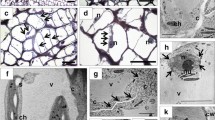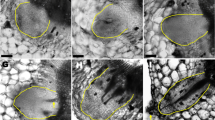Abstract
Abscission facilitates growth and reproduction and improves plant defenses against pathogens. This tightly regulated process is triggered by environmental cues and hormones such as ethylene and auxin. Because auxin is crucial for abscission, auxin response factors (ARFs) may play important roles in this process. Here, we examined changes in gene expression during abscission in tomato, focusing on regulation of genes encoding ARFs. Specifically, we analyzed the pattern of ARF gene expression in tomato flower pedicel explants treated with ethylene, the ethylene blocker 1-methylcyclopropene (1-MCP), or auxin to determine how auxin and ethylene affect ARF gene expression. In addition, we examined the spatial and temporal distribution of IAA during abscission by examining transgenic tomato plants expressing an IAA-inducible promoter fused to the GUS reporter gene (the P5::GUS ‘Chico III’ line). Flower removal from the explants quickly induced abscission by ethylene, which was inhibited by exogenous auxin or 1-MCP. During early abscission, auxin (or 1-MCP) regulated the expression of various ARFs, including ARF1, 2, 3, 4, 5, 7, 8-1, 9, 11, 12, 13, 13-1, 14, and 17, whereas ethylene had the opposite effect on most of these genes. Further analysis shows that during this stage, auxin may mediate the expression of ARF8-1, 9, 11, 12, 13, 13-1, and 14, whereas ethylene may mediate ARF13-1. During the later stage of abscission, ARF2, 8, 10, 11, and 19 were upregulated, and 8-1, 12, 13, and 13-1 were downregulated, compared with nonabscising parts of plants. Fluorometric GUS analysis indicated that GUS activity in the abscission zone remained stable at 4 h and sharply decreased after 8 h until abscission was complete (32 h).








Similar content being viewed by others
References
Agusti J, Merelo P, Cercós M, Tadeo FR, Talón M (2008) Ethylene-induced differential gene expression during abscission of citrus leaves. J Exp Bot 59:2717–2733
Agusti J, Merelo P, Cercós M, Tadeo FR, Talón M (2009) Comparative transcriptional survey between laser-microdissected cells from laminar abscission zone and petiolar tissue during ethylene-promoted abscission in citrus leaves. BMC Plant Biol 9:127
Chinchilla D, Zipfel C, Robatzek S, Kemmerling B, Nürnberger T, Jones JD, Felix G, Boller T (2007) A flagellin-induced complex of the receptor FLS2 and BAK1 initiates plant defence. Nature 448:497–500
Cho SK, Larue CT, Chevalier D, Wang H, Jinn TL, Zhang S, Walker JC (2008) Regulation of floral organ abscission in Arabidopsis thaliana. Proc Natl Acad Sci USA 105:15629–15634
de Jong M, Wolters-Arts M, Feron R, Mariani C, Vriezen WH (2009) The Solanum lycopersicum auxin response factor 7 (SlARF7) regulates auxin signaling during tomato fruit set and development. Plant J 1:160–170
Ellis CM, Nagpal P, Young JC, Hagen G, Guilfoyle TJ, Reed JW (2005) Auxin response factor1 and auxin response factor2 regulate senescence and floral organ abscission in Arabidopsis thaliana. Development 132:4563–4574
Fukaki H, Nakao Y, Okushima Y, Theologis A, Tasaka M (2005) Tissue-specific expression of stabilized SOLITARY-ROOT/IAA14 alters lateral root development in Arabidopsis. Plant J 44:382–395
Gray W, Kepinski S, Rouse D, Leyser O, Estelle M (2001) Auxin regulates SCFTIR1-dependent degradation of AUX/IAA proteins. Nature 414:271–276
Hardtke CS, Ckurshumova W, Vidaurre DP, Singh SA, Stamatiou G, Tiwari SB, Hagen G, Guilfoyle TJ, Berleth T (2004) Overlapping and non-redundant functions of the Arabidopsis auxin response factors monopteros and nonphototropic hypocotyl 4. Development 131:1089–1100
Jain M, Nijhawan A, Tyagi AK, Khurana JP (2006) Validation of housekeeping genes as internal control for studying gene expression in rice by quantitative real-time PCR. Biochem Biophys Res Commun 345:646–651
Jefferson RA (1987) Assaying chimeric genes in plants: the GUS gene fusion system. Plant Mol Biol Report 5:387–405
Jefferson RA, Burgess SM, Hirsch D (1986) β-Glucuronidase from Escherichia coli as a gene-fusion marker. Proc Natl Acad Sci USA 83:8447–8451
Jinn TL, Stone JM, Walker JC (2000) HAESA, an Arabidopsis leucine-rich repeat receptor kinase, controls floral organ abscission. Genes Dev 14:108–117
Karlova R, Boeren S, Russinova E, Aker J, Vervoort J, de Vries SC (2006) The Arabidopsis somatic embryogenesis receptor-like kinase1 protein complex includes brassinosteroid-insensitive 1. Plant Cell 18:626–638
Kavita P, Burma PK (2008) A comparative analysis of green fluorescent protein and β-glucuronidase protein-encoding genes as a reporter system for studying the temporal expression profiles of promoters. J Biosci 33:337–343
Kinoshita T, Caño-Delgado A, Seto H, Hiranuma S, Fujioka S, Yoshida S, Chory J (2005) Binding of brassinosteroids to the extracellular domain of plant receptor kinase BRI1. Nature 433:167–171
Li J, Wen J, Lease KA, Doke JT, Tax FE, Walker JC (2002) BAK1, an Arabidopsis LRR receptor-like protein kinase, interacts with BRI1 and modulates brassinosteroid signaling. Cell 110:213–222
Mallory AC, Bartel DP, Bartel B (2005) MicroRNA-directed regulation of Arabidopsis auxin response factor 17 is essential for proper development and modulates expression of early auxin response genes. Plant Cell 17:1360–1375
Mazzucato A, Olimpieri I, Rossi M, Caccia R, Soressi GP (2006) A new reporter construct to monitor IAA dynamics during tomato development. TGC Rep 56:26–28. Available at http://tgc.ifas.ufl.edu/vol56/vol56.pdf
Meir S, Philosoph-Hadas S, Sundaresan S, Vijay Selvaraj KS, Burd S, Ophir R, Kochanek B, Reid MS, Jiang CZ, Lers A (2010) Microarray analysis of the abscission-related transcriptome in the tomato flower abscission zone in response to auxin depletion. Plant Physiol 4:1929–1956
Nagpal P, Ellis CM, Weber H, Ploense SE, Barkawi LS, Guilfoyle TJ, Hagen G, Alonso JM, Cohen JD, Farmer EE (2005) Auxin response factors ARF6 and ARF8 promote jasmonic acid production and flower maturation. Development 132:4107–4118
Okushima Y, Overvoorde PJ, Arima K, Alonso JM, Chan A, Chang C, Ecker JR, Hughes B, Lui A, Nguyen D (2005) Functional genomic analysis of the auxin response factor gene family members in Arabidopsis thaliana: unique and overlapping functions of ARF7 and ARF19. Plant Cell 17:444–463
Pasternak TP, Prinsen E, Ayaydin F, Miskolczi P, Potters G, Asard H, Onckelen HAV, Dudits D, Fehér A (2002) The role of auxin, pH, and stress in the activation of embryogenic cell division in leaf protoplast-derived cells of alfalfa. Plant Physiol 129:1807–1819
Roberts JA, González-Carranza ZH (2007) Abscission. In: Roberts K (ed) Handbook of plant science, vol 1. Wiley, Chicester, pp 512–519
Stenvik GE, Tandstad NM, Guo Y, Shi CL, Kristiansen W, Holmgren A, Clark SE, Aalen RB, Butenko MA (2008) The EPIP peptide of inflorescence deficient in abscission is sufficient to induce abscission in Arabidopsis through the receptor-like kinases HAESA and HAESA-LIKE2. Plant Cell 20:1805–1817
Szemenyei H, Hannon M, Long JA (2008) TOPLESS mediates auxin-dependent transcriptional repression during Arabidopsis embryogenesis. Science 319:1384–1386
Tatematsu K, Kumagai S, Muto H, Sato A, Watahiki MK, Harper RM, Liscum E, Yamamoto KT (2004) MASSUGU2 encodes Aux/IAA19, an auxin-regulated protein that functions together with the transcriptional activator NPH4/ARF7 to regulate differential growth responses of hypocotyl and formation of lateral roots in Arabidopsis thaliana. Plant Cell 16:379–393
Tian Q, Uhlir NJ, Reed JW (2002) Arabidopsis SHY2/IAA3 inhibits auxin-regulated gene expression. Plant Cell 14:301–319
Tian Q, Nagpal P, Reed JW (2003) Regulation of Arabidopsis SHY2/IAA3 protein turnover. Plant J 36:643–651
Tian CE, Muto H, Higuchi K, Matamura T, Tatematsu K, Koshiba T, Yamamoto KT (2004) Disruption and overexpression of auxin response factor 8 gene of Arabidopsis affect hypocotyl elongation and root growth habit, indicating its possible involvement in auxin homeostasis in light condition. Plant J 3:333–343
Tucker ML, Yang RH (2012) IDA-like gene expression in soybean and tomato leaf abscission and requirement for a diffusible stelar abscission signal. AoB Plants 2012: pls035. doi:10.1093/aobpla/pls035
Uehara T, Okushima Y, Mimura T, Tasaka M, Fukaki H (2008) Domain II mutations in CRANE/IAA18 suppress lateral root formation and affect shoot development in Arabidopsis thaliana. Plant Cell Physiol 49:1025–1038
Ulmasov T, Hagen G, Guilfoyle TJ (1999a) Activation and repression of transcription by auxin response factors. Proc Natl Acad Sci USA 96:5844–5849
Ulmasov T, Hagen G, Guilfoyle TJ (1999b) Dimerization and DNA binding of auxin response factors. Plant J 19:309–319
Wang SC, Tiwari SB, Hagen G, Guilfoyle TJ (2005a) Auxin response factor7 restores the expression of auxin-responsive genes in mutant Arabidopsis leaf mesophyll protoplasts. Plant Cell 17:1979–1993
Wang YC, Li TL, Meng HX, Sun XY (2005b) Optimal and spatial analysis of hormones, degrading enzymes and isozyme profiles in tomato pedicel explants during ethylene-induced abscission. Plant Growth Regul 46:97–107
Weijers D, Benkova E, Jäger KE, Schlereth A, Hamann T, Kientz M, Wilmoth JC, Reed JW, Jürgens G (2005) Developmental specificity of auxin response by pairs of ARF and Aux/IAA transcriptional regulators. EMBO J 24:1874–1885
Wilmoth JC, Wang S, Tiwari SB, Joshi AD, Hagen G, Guilfoyle TJ, Alonso JM, Ecker JR, Reed JW (2005) NPH4/ARF7 and ARF19 promote leaf expansion and auxin-induced lateral root formation. Plant J 43:118–130
Zuo XH, Xu T, Qi MF, Lv SS, Li H, Gao S, Li TL (2011) Expression patterns of auxin-responsive genes during tomato flower pedicel abscission and potential effects of calcium. Aust J Bot 60:68–78
Acknowledgments
This work was supported by Grants from the National Natural Science Foundation of China (Nos. 31272153, 31171966, 31071789, and 30900982) and China Agricultural Research System (CARS-25). We also acknowledge Dr. A. Mazzucato for providing transgenic tomato seeds. We thank the native English-speaking scientists of Elixigen Company for editing our manuscript.
Author information
Authors and Affiliations
Corresponding author
Additional information
Xiaoxi Guan and Tao Xu equally contributed to this work and should be considered co-first authors.
Electronic supplementary material
Below is the link to the electronic supplementary material.
344_2013_9377_MOESM1_ESM.tif
Supplementary Fig. 1 Relative expression of Cystein-type endopeptidase in AZ of tomato pedicels treated with water for 1 h or with MES for 3 h (TIFF 90 kb)
344_2013_9377_MOESM2_ESM.tif
Supplementary Fig. 2 Localization of GUS activity in flower pedicel explants treated with water for 1 h (a) or MES for 3 h (b) (TIFF 370 kb)
344_2013_9377_MOESM3_ESM.tif
Supplementary Fig. 3 IAA concentration (a) and GUS activity (b) analysis in AZ of tomato pedicels treated with water for 1 h or MES for 3 h (TIFF 110 kb)
344_2013_9377_MOESM4_ESM.tif
Supplementary Fig. 4 After water incubation for 1 h, the different treatments resulted in the differential expression of genes, which comprised two major clusters: cluster A (5 genes) and cluster B (16 genes) (TIFF 114 kb)
344_2013_9377_MOESM5_ESM.tif
Supplementary Fig. 5 After MES incubation for 3 h, the different treatments resulted in differential expression of genes, which comprised two major clusters: cluster A (8 genes) and cluster B (13 genes) (TIFF 121 kb)
Rights and permissions
About this article
Cite this article
Guan, X., Xu, T., Gao, S. et al. Temporal and Spatial Distribution of Auxin Response Factor Genes During Tomato Flower Abscission. J Plant Growth Regul 33, 317–327 (2014). https://doi.org/10.1007/s00344-013-9377-x
Received:
Accepted:
Published:
Issue Date:
DOI: https://doi.org/10.1007/s00344-013-9377-x




